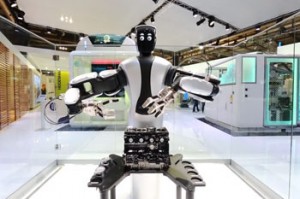Comau launches Amico humanoid robot at EMO
 Comau has introduced a new two-armed, humanoid robot which it says clarifies and emphasises its next steps towards a future where man-machine cooperation evolves from mere hypothesis to a real production opportunity that can be applied in total safety.
Comau has introduced a new two-armed, humanoid robot which it says clarifies and emphasises its next steps towards a future where man-machine cooperation evolves from mere hypothesis to a real production opportunity that can be applied in total safety.
Amico is a “technical and communicative concept” chosen by Comau to represent the robot’s ability to work in small spaces with the maximum precision and flexibility. Based on Racer3 technology, Comau says it also demonstrates the possibility to mount Racer3 in any position and the clever mix of technology and design that characterises Racer3 and enables it to bend and reach the surrounding space.
A particular feature of Amico is its gripping mechanism, with each arm featuring Schunk SDH2 grippers. This multi-articulated gripping system with three fingers has the ability to grasp a wide range of objects, making it perfect for industrial robotic applications.
Two of the Schunk gripper fingers can, in fact, change their orientation to adapt to a wide variety of applications. The gripper is also able to recognise each surface and release the necessary strength through a specific sensor. In addition to extreme precision, this allows the robot to immediately understand whether the gripping is optimal or should be adjusted.
Comau says the Amico robot, which has just been presented to the market, is a symbol of its new robotics paradigm.
Built entirely in aluminium and magnesium, Racer3 weighs just 30kg and features a maximum reach of 630mm and a payload of 3kg. As such, it is perfect for applications including assembly, material handling, machine tending, dispensing, pick and place, etc, which require the maximum precision and velocity in small work spaces.
Visit the Comau website for more information.















